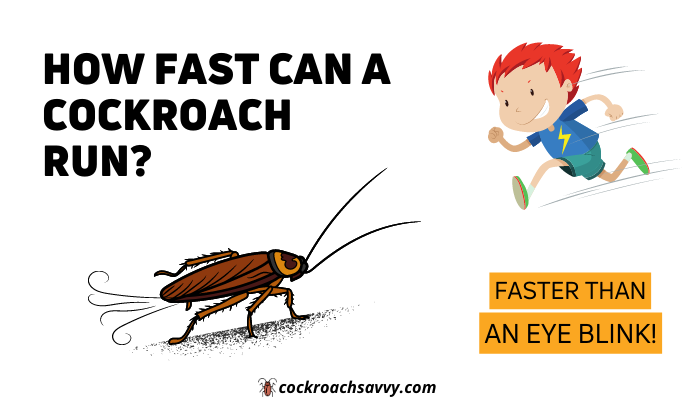Cockroach Running Speed
Speed of American Cockroach
The American Cockroach is like the Usain Bolt of the insect world. They can zoom across 5 feet in a single second, clocking in around 3.4 miles per hour (source: Hulett Environmental Services Blog). That’s pretty swift for a tiny critter, making them one of the fleetest bugs around.
Picture them sprinting on different surfaces:
| Surface Type | Maximum Speed (m/s) |
|---|---|
| Non-slippery ground | 0.35 |
| Slippery surfaces | 0.25 |
Research from Frontiers in Zoology shows these little speedsters hit about 0.35 m/s on firm soil, but they slow to 0.25 m/s on slick spots. Even so, they aren’t exactly slouching, taking up to 15 strides per second on any surface.
Cockroach Balance Recovery
Give a cockroach a push or a spin, and you’ll see it perform a quick flip and keep on trucking. These bugs flip back on their feet faster than you can blink. Thanks to their light body armor and ninja-like leg coordination, they bounce back from tumbles quickly.
This knack for bouncing back is super handy when maneuvering over stuff in their path. Dive into more bug ninja moves with articles like how do cockroaches climb walls and how do cockroaches survive without heads.
Cockroaches’ elusive speed and nimbleness make them difficult to catch. Understanding their movements is key to staying one step ahead in the pest game. For more tips on their midnight shenanigans and best ways to boot them out of your cabinets, see why do cockroaches come out at night and how to get rid of cockroaches in cabinets.
Cockroach Movement Patterns
Cockroaches scoot around like little speed demons using different leg styles to zip through their surroundings. Really getting the hang of these funky leg dances can clue us into just how zippy they can be, making them the agility champs of the bug world.
Metachronal Gait
With metachronal gait, each of their six little legs has its solo dance move. In a wave-like jig, they each take their turn, which is the cockroach go-to for high-speed chases.
- Roaches crank up the pace with their ‘metachronal’ leg shuffle when they need some serious hustle, keeping their cool while they speed up, as seen in Nauphoeta cinerea (Props to Arizona Pest Control).
- Picture scientists poking roaches with air bursts or tickling them with brushes to jumpstart their sprint and watch the switch to metachronal fancy-footwork for speed (Arizona Pest Control).
- Some nerdy study even spotted them switching up their leg strategy from a tripod to a metachronal shuffle to hit the fast lane.
Tripodal Gait
Tripodal gait is like the cockroach’s foolproof mode of getting around, using three legs at all times. Two on one side, one on the other, keeping their roach bodies steady on their speedy mission.
- Starting their scuttle, roaches rock the “tripodal” jig. Two legs on one side and a lonely leg on the other drop the beat for a cockroach groove, ensuring they maintain their swift and stable pace.
These movement patterns don’t just look cool; they’re practical, too. They help cockroaches dodge the swatter and wind their way through tricky spots. When you get a grip on these moves, you’ll start to see why roaches are tough customers, never easily cornered and living it up just about everywhere.
| Gait Type | Fancy Moves | What Makes Them Bust It Out |
|---|---|---|
| Metachronal | Legs movin’ like dominos in a wave | When speed and balance are the game |
| Tripodal | Three legs always keeping in touch with terra firma | Kicking things off in their little scuttle |
Want to know more wild stuff about these indestructible bugs? Check out how they handle scaling new heights in cockroach wall climbing, how they manage without noggins in cockroach survival without heads, or how they keep breathing in cockroach breathing mechanics.
Cockroach Racing Experiments
Thomas Merritt’s Experiment
Back in 1999, entomologist Thomas Merritt took a wild leap into the world of bugs to find out which one was the speed demon among them. The gold medal went to the American cockroach, clocking a nimble 3.4 mph. This reinforced the idea that these roaches aren’t just kitchen invaders but are also built like the Usain Bolts of the insect rank Hulett Environmental Services Blog.
University of Cologne Research
Tom Weihmann, a science buff from the University of Cologne, decided to dig deeper into what makes cockroaches such capable sprinters. His team discovered these bugs have a sneaky trick up their sleeves—they can switch from just crawling to a full-on run and are the first bugs known to pull this off Arizona Pest Control.
When cockroaches start their motors, they use a “tripodal gait,” which means they always keep three feet on the ground: two on one side, one on the other. It’s like a living tripod, keeping them steady and zippy at the same time. This smart shuffle helps them stay balanced while they dash off, and they use it pretty well to dodge predators or swatters Arizona Pest Control.
The crew at Cologne got creative, nudging the tiny racers with a breeze or a ticklish paintbrush to see them scamper. These crafty critters showed they could sync up their legs like pro dancers to zip around with some style and grace Arizona Pest Control.
The scientists set up a little cockroach Olympics on a fifty-centimeter track, clipping their wings to make sure it wasn’t an aerial show. The chase was on, highlighting how these little fellas can hit the ground running, both literally and figuratively Arizona Pest Control.
For more bizarre bug facts, you might want to check out the mysteries of the night-loving behaviors of roaches why do cockroaches come out at night, their airborne capabilities can cockroaches fly, and how they defy gravity how do cockroaches climb walls.
Cockroach Agility
Cockroaches, the tiny superheroes of the bug world, don’t get enough credit for their ninja-like moves. Their speed and tricks make them masters at dodging and weaving through life’s little obstacles. Let’s jump into their secret climbing powers and how they zoom past like little jet-fueled critters.
Climbing Abilities
When it comes to wall-crawling, cockroaches own the game. They scuttle up walls, creep along ceilings, and navigate those rocky paths like it’s nobody’s business (Cockroach Savvy). You can thank their sticky little feet and a muscle system that works like a well-oiled machine for their climbing prowess.
| What They’re Packing | How It Helps |
|---|---|
| Sticky Feet | Helps them cling to anything |
| Where They Go | From walls to ceilings and rough patches |
These sneaky little climbers make catching them a near-mythical adventure. Curious how they stick to walls like Spidey? Check out our piece on how do cockroaches climb walls.
Energy Efficiency in Movement
Cockroaches don’t just run; they sprint like they’re in a bug olympics. They’re not just quick, they’re energy-saving marvels too. When danger looms, they hit the pavement at breakneck speeds to get away or find a comfy hidey-hole (Cockroach Savvy).
| Bug Zoom Stats | Details |
|---|---|
| Max Speed on Dry Grounds | Hits 0.35 m/s (Frontiers in Zoology) |
| Max Speed on Slippery Floors | Maxes out at 0.25 m/s (Frontiers in Zoology) |
| Leg Movement | About 15 strides every second |
When they’re sprinting at top speed, they switch up their leg game to a fancy footwork pattern, turning what could be a greasy slip ‘n slide into a graceful sprint.
Getting to know how cockroaches hustle and bustle gives us a peek into their world-saving skills. Wanna dive deeper into their incredible abilities? Check out our reads on how do cockroaches breathe and how smart are cockroaches.
Cockroach Leg Coordination
Gait Changes at High Speeds
Cockroaches sure know how to hustle when they need to. As they pick up the pace, these little critters swap their usual step pattern for something even more effective. The typical “tripod” movement gets traded for a more sophisticated dance known as the metachronal gait. This switch is like moving from a jog to a graceful sprint, allowing them to zip around with ease.
In the metachronal gait, the body stays pretty steady – there’s less bouncing up and down, and the ride is smoother compared to the tripod gait. You can imagine this being like cruising in a car with excellent shock absorbers. The low bobbing of their bodies also means that these roaches are conserving energy and maintaining stability even when they’re zooming around.
| Gait Type | Speed | Center of Mass Amplitude | Vertical Acceleration |
|---|---|---|---|
| Tripod Gait | Lower | Higher | Higher |
| Metachronal Gait | Higher | Lower | Lower |
This neat footwork change not only lets them hustle faster but also helps them slick across different terrains. The staggered way their feet hit the ground improves glide on slippery surfaces, saving energy in the process.
Leg Synchrony and Coordination
Every leg knows its role in the cockroach dash! When danger is near, their legs play the team: what was a more synchronized step changes with the fast pace, and the order goes out the window. Instead, each leg moves with a little less company but a lot more swing and speed (Frontiers in Zoology).
| Gait Type | Leg Synchrony | Lateral Amplitudes | Lateral Acceleration |
|---|---|---|---|
| Tripod Gait | Higher | Lower | Lower |
| Metachronal Gait | Lower | Higher | Higher |
The staggered steps during the metachronal gait mean every foot moves on its own timeline. This timing trick keeps them grounded without the need for extra muscles to store and release energy.
If you’re keen to know more about how cockroaches pull off these amazing feats, dive into our stories on how fast can cockroaches run and how do cockroaches climb walls.

